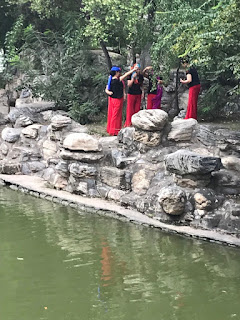Singing Contests, Spontaneous Dance and Music.
Last Friday, Dave and I were asked to judge a singing
competition. It was sort of “China’s Got
Talent” moment, hosted by the Foreign Language Students. The rules were the students had to sing in a
language that wasn’t their native language.
There were 16 competitors. They
all sang one song. We voted. Then there was a second round where 10 were
eliminated and so we only had to listen to 6 in the second round. They were supposed to sing a song in a
different style in the second round, although I’ll be hard pressed to figure out what constituted a “different stye.
Ariana Grande? Rihanna? I guess
that’s a different style.
The students sang in Italian, Japanese – but most sang in
English. I wanted to reward the student who sang the Italian love song, but it
was pretty awful. The winners were quite
good. One sang Rihanna’s “Diamonds” –
which I think is a very hard song to sing and carry off. She had great presence, and made it her
own. Second place was a duo – two women
who sang in harmony. They were right on,
in terms of pitch, and seemed to be enjoying themselves as they engaged the
audience. Third place was my
favorite. His name was Winnie, and he
sang “Fly me to the moon” and had Sinatra’s mannerisms. It was fun to see the students outside of
the classroom, enjoying themselves on a Friday evening. The hall was packed, and there was a lot of
audience support.
I wanted to write this entry because I have, overall, been
charmed by the prevalence of music – everywhere.
 |
| Dancing women, practicing in the park |
If you walk round a park, you
inevitably will stumble upon a group of older folks, sitting around playing
traditional musical instruments.
 |
| Park musician |
In that same park, there is a huge
tree with benches around it. I call it
the “Karaoke Tree.” There is sound
equipment and always there is someone there with a group around the tree
singing a traditional C-pop song.
Walking back to the apartment,
over a bridge, I look over the side and
– there is another group of 40-something women dressed in color-coordinated
costumes, practicing a dance.
Late at night, Dave and I walk by
the park again, and lo and behold, its filled with dancers. There are no lights, just boom-boxes and
groups of 20-50 people scattered through the park. Some are ball-room dancing. Some are line-dancing. Some are doing a cool kind of moon-walk
dance. It’s a Saturday night spontaneous
event.
To recognize the ubiquitous of music in this culture, I gave
my students the option of writing their Comparison and Contrast essay comparing
contemporary music to Chinese classical music.
Not many people took me up on the offer, but one of my students, Tina,
has expressed a love of ancient Chinese arts and is a musician herself. This is what she came up with:
Chinese classical music refers to Chinese
traditional music, which has a long history and can be traced back to Xia and
Shang Dynasty. Many of Chinese classical music pieces are familiar to us, such as Mountain Stream or The Song and
The Moon over a Fountain. The instruments of Classical music are often Chinese
traditional instrument like Bamboo Flute and Gu Zheng. When composing Chinese
Classical Music, Chinese musicians optimize the combination of instruments, and
lay emphasis on balance of the tone. So this kind of music always has beautiful
or peculiar melodies, fun-filled music, and sincere emotion. Additionally, the
main purpose of Chinese classical music is to mold character, and it’s also the
precious historical material which records the customs of the past.


Contemporary music is the music which is created with new composition
techniques and music theory. Contemporary music’s melody is always smooth,
undulating and regular. Famous modern music has Yesterday and Lincoln Park. As
for the instrument, contemporary music often uses stringed instruments. It emphasizes
the extreme sound area and noise, highlights percussion, and seeks new sound
colors and sound instruments. What’s more, Contemporary music reflects modern
life, and it always keeps up with the trend of the times.
Admittedly music is central to most cultures. To document my memories of the music that I’ve
encountered here, I’ve started to collect pictures of musicians in the various
museums that we’ve visited.
Here are some dancing figures from the Tang Dynasty (800-900ish), who were dug up right here, in Xi'an.
These three women are from the Ming dynasty
(1368-1644). They were buried in Zhu
Gongdu’s tomb, to entertain in the afterlife.
These three lovely women are from the 16-Kingdom period (304-409) – a period when the dynasties were fracturing and fragmenting. But obviously the inhabitants still had time for music.
These three lovely women are from the 16-Kingdom period (304-409) – a period when the dynasties were fracturing and fragmenting. But obviously the inhabitants still had time for music.
 |
| 16-Kingdom Musicians |
But my favorite is this group of traveling musicians from the Tang Dynasty (700-800ishAD). They’re riding a camel, coming East, perhaps, on the Silk Road. They’re bringing music from – perhaps Persia or Tibet? I can’t tell if the camel likes the accompaniment or is rebelling. Dad, maybe you can paint us a picture of this?




Keep a song in your heart!
ReplyDeleteHearts!
ReplyDelete